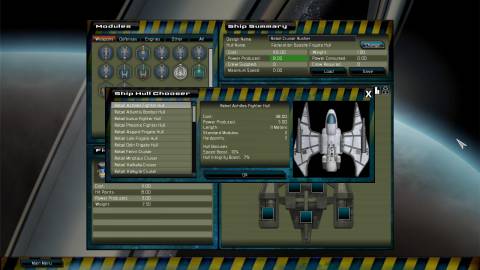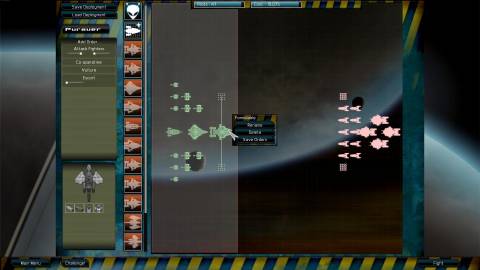Overview
Gratuitous Space Battles resembles a real time strategy game at first glance, but the game has more in common with tower defense games combined with editors in certain 4X games. The objective is not to directly order ships around. As a general, you give out overarching orders that your units will attempt to follow on their own. The main game actually takes place before each battle in the ship customization and fleet deployment stage.
Races
Federation
As the starting race, the Federation is the least surprising of the four factions. Their ships are an average mix of reasonably fast fighters, decent frigates, and cruisers that can easily perform any number of tasks. Their ships vaguely resemble Star Trek style ships painted a deep blue.
The Federation is the largest economic force in the galaxy and their navy is used for enforcing contracts rather than war.
Rebels
The Rebels are unlocked by beating all the scenarios on normal. They are similar to the Federation in that they provide no-nonsense, balanced ships, but their ships can support more modules making them more expensive but stronger than their Federation counterparts (if designed correctly). They currently field the fastest fighters in the game. Their ships look similar to Empire designs from Star Wars.
The Rebels broke off from the Empire seeking to end the continual lifetime military demands of the Empire. Without sensing any irony, the Rebels have devoted their lives to fighting off the Empire... militarily.
Empire
The Empire is unlocked by beating all the scenarios on hard. The Empire ships are a strange set of fragile spherical shaped ships with delicate superstructure showing. Their ships may not be able to withstand fire without heavy shielding, but they can hold the highest amount of modules. Frigates, for example, can hold up to nearly as many modules as other race's cruisers. Despite this advantage, their ships are therefore far more costly fully specced out.
Alliance
The Alliance is unlocked by beating all the scenarios on expert. The Alliance rely on an extremely varied mix of ships that rely on fleet cohesion or some overall strategy to claim victory. They have a cruiser with the least amount of modules in the game and another with the most amount of hardpoints. This mix makes them the most difficult to use but possibly the most effective.
The Alliance itself is made up of a various mix of insect races (hence their diverse designs). They are united only by their hatred of everything biped.
Game Modes
Campaign
The campaign is a series of missions of selectable difficulty with pre-built enemy fleet deployments. The campaign, overall, is much easier than the average multiplayer challenge mission.
Challenges
Other players can send their hardened fleets to be tested against all players or in a single duel for honor. Challenges can be rated by enjoyment and difficulty.
Survival
The objective is to deploy a fleet which is capable of surviving against a continual wave of enemies. The top players are recorded on a leaderboard by highest score.
Gameplay
The game itself is divided up into three stages: ship customization, fleet deployment, and the actual battle.
Ship Customization
 My God, It's Full of Stars.
My God, It's Full of Stars.Before one deploys a fleet of ships, you should customize each ship according to your specifications. At first this might look a little daunting, but the bulk of the game can be won in the design stages before actual deployment. The best ships are those designed for a specific purpose or role and as a part of the overarching strategy.
There are three main ship classes:
- Fighters - Too weak to withstand much fire, a fighter must use speed as a primary defense. Fighters can fly right past shielding and target a ship directly. Lightly armored frigates and cruisers can be quickly destroyed if they do not have the appropriate defenses or anti-fighter coverage. Fighters, unfortunately, require more dedicated pilots than any other ship class. Fighters have few hardpoints or modules and can only equip a couple weapons at most.
- Frigates - Much smaller and comparatively cheaper than their cruiser counterparts, frigates cannot rely solely on shields or armor to withstand battle. In large numbers, frigates can put a devastating amount of firepower onto enemy fleets along with some useful modules like shield disruptors or temporarily crippling ECM missiles. Most Frigates hold around four hardpoints for weapons and a good number of regular modules.
- Cruisers - Most of the devastating weapons modules are found solely on cruisers, but cruisers sacrifice most of its speed for survivability and heavy firepower. A single cruiser armed with heavy shields, high shield regeneration, thick armor, and multiple repair modules can tank many ships at once. Cruisers come with the heaviest armor along with the best defense weapons in the game such as the ECM beam. Cruisers can hold up to nine hardpoints and a high number of regular modules allowing for much greater customization than other ship classes.
Fleet Deployment
Countering enemy fleets requires smartly deploying ships. A giant ball of cruisers and frigates churning plasma and lasers in your direction is devastating, but all ships will explode on death thereby damaging surrounding ships. Instead, a smart deployment is needed for victory.

Every scenario has a certain set limit on pilots and money. Fighters take the most amount of pilots to manage. Cruisers will increase the cost the quickest. Ships of different speeds can quickly result in a disorganized attack. To manage everything, each ship should be given orders instead of using the default provided.
Ship captains will follow your orders exactly, it would be best to remember they cannot read your mind. Orders span a myriad of tactics such as "Attack a ship class at a certain range," "Retaliate against any ship firing at you," or "Stay within formation or range of a certain ship." Using these orders, one can create a suicidal fleet of rushers who fire only until they see the whites of their enemies' eyes or a cautious fleet full of cowards who run at the slightest damage.
Gratuitous Space Battling
This is the final stage of the game where all your hard work either pays off or goes down in flames. The only control you have over this point of the game is speeding up or slowing down gameplay, taking a pretty screenshot, or screaming in frustration as your fleet is crushed.
If your fleet is losing, keep track of what needs to be improved. Your deployments are almost guaranteed to lose versus online challenges. Many challenges posted by other players rely either on a clever mix of strategy or some notable gimmick that can often be difficult to defeat the first time.
Modules / Hardpoints
Weapon Module Types
- Beam Weapons - These weapons are made to break through heavily fortified ships with their high armor penetration. Beam-type weapons will not penetrate heavy shielding, however.
- Plasma Weapons - Plasma weaponry has a good combination of high armor and shield penetration. Plasma-equipped ships are very good at destroying a heavily shielded ship by bleeding through shields. The main weakness of all plasma weapons is the low accuracy provided by slow tracking rates.
- Missile Weapons - Although easily intercepted, missiles provide a good balance between shield and armor penetration. Missiles have the longest range of any weapon especially all cruiser variants. Faster or more powerful versions of missiles sacrifice this range advantage for their uniqueness.
- Pulse Weapons - Weapons such as lasers or quantum blasters appear to have much lower damage potential, but their high fire rate more than makes up for their inadequacies. These fast firing weapons often trade maximum range for a lower minimum range. Frigates or cruisers armed with these weapons can rip right through shields and armor if they can get close enough.
- ECM Shock - This weapon will temporarily disable any ship it hits.
Defense Module Types
- Armor - Without armor, all damage that penetrates shielding will hit important modules. Multiple armor modules can dramatically increase survivability, but the price and weight of the heaviest ultra-armor can be far too costly. Lighter armor modules may be best suited to ships not meant to be at the frontline.
- Shielding - Shielding automatically recharges. A well built ship with good shielding can recharge slightly faster that damage coming in, but even the best shielding succumbs quicker than armor.
- Anti-Missile - To deflect missiles, these defenses will either destroy or use ECM to confuse missile guidance systems. The ECM version of this defense can hit more missiles than the defense beams which destroy missiles.
- ECM-Shielding - ECM-shielding is a direct counter to ECM Shock albeit will not stop all incoming attempts.
Support Module Types
- Repair Modules - These repair modules can either focus solely on armor or have a more general purpose use. Without these modules, all damage past shielding will be permanent. Be warned that repair modules have only a limited supply for repairs.
- Crew Modules - Most modules will need crew members to man. The more crew needed, the more expensive the module or modules will be required.
- Powerplant Modules - These modules keep the lights on and the guns firing. Multiple powerplant modules will cause a higher explosion at death, but the risk is sometimes worth it for the firepower.
PC System Requirements
- OS: Windows XP or Vista
- Processor: 1.5 GHz processor
- Memory: 1GB
- Graphics: 3D Card with 128MB video memory
- DirectX®: 9.0c
- Hard Drive: 300 MB
- Sound: Any
Mac System Requirements
- OS: OS X version Leopard 10.5.8, Snow Leopard 10.6.3, or later.
- Processor: Intel 1 Ghz
- Memory: 512 MB
- Graphics: 32MB video card
- Hard Drive: 75 MB
Log in to comment